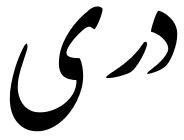Language/Dari/Culture/Famous-Dari-Writers
| ◀️ Future Tense — Previous Lesson | Next Lesson — Dari Media ▶️ |
Dari (known as Afghan Persian) is widely used in Afghanistan and Iran, serving as the medium of instruction in many educational institutions. With several centuries of rich literary history, Dari Literature is known for its ornate and graceful language style, which brings to light the culture and architectural splendor of the region.
This lesson will cover the works of famous Dari writers, poets, and playwrights, highlighting their significant contributions to Dari literature and culture.
Take some time to dive into these other pages after completing this lesson: Afghanistan and Iran & Holidays and Celebrations.
Nasir Khusraw
Life and Work
Nasir Khusraw was a renowned Persian scholar, poet, and traveler, believed to have lived between 1004 and 1088 AD. He wrote extensively on a variety of topics, such as philosophy, theology, ethics, and literature. He is best known for his literary works, including poetry and prose, written in Farsi and Dari languages. His magnum opus, ‘Safarnameh,’ or ‘Book of Travels,’ is a travelogue that describes his seven-year-long journey from present-day Iran to Mecca and back.
Famous Works
‘Safarnameh’ is Nasir Khusraw’s most celebrated work. Written in elegant Dari prose, it provides a vivid account of his travels through the Islamic lands on his way to Mecca, his visits to historical monuments such as the Sphinx, and his interactions with different cultures and people he met on his journey. Other notable works of his include ‘The Divan,’ a collection of poems, and ‘Jami al-Hikmatayn,’ a philosophical treatise.
| Dari | Pronunciation | English Translation |
|---|---|---|
| سهٔ طلا | Seh-e-Tala | Three Gold Coins |
| فرنگی و عربی | Farangi-o-Arabi | Persian and Arabic |
| بُلبُل | Bolbol | Nightingale |
Jami
Life and Work
Jami (1414-1492) was one of the greatest Persian poets of the 15th century. Born in the city of Jam, in present-day Afghanistan, he wrote primarily in Dari and Farsi, incorporating a range of themes such as love, spirituality, and social issues in his poems. Jami also excelled as a historian, philosopher, and scholar, with several of his literary works exploring religious and ethical ideas.
Famous Works
Jami’s most famous work is ‘Haft Awrang,’ or the ‘Seven Thrones,’ which is an epic poem consisting of seven books, each dealing with a different aspect of human life. The themes covered in the books include religion, love, ethics, metaphysics, and the cosmos. Another notable work of his is ‘Lawa’ih,’ a collection of poems that explores courtly love. Other notable works of Jami include ‘Silsilat Al-Dhahab’ and ‘Nafahat Al-Uns.’
| Dari | Pronunciation | English Translation |
|---|---|---|
| مُثَمِرات الاَرْوَاح | Mothamerat-ul-Arwah | The Perfumed Garden |
| تحفةالاحرار | Tuhfat-ul-Ahrar | The Gift of Free Men |
| صَوْمَعَه سُحَن | Saumah-o-Suhan | Fasting and Prayer |
Abdul Rahim Khane-e-khana
Life and Work
Abdul Rahim Khane-e-khana (1556-1627) was a Mughal statesman, poet, and warrior who served under Emperor Akbar. A prolific writer, Khane-e-khana is best known for his contributions to Indian and Central Asian literature, notably his works in the Dari language. He is credited with creating the Khojos, a form of Persian poetry that made extensive use of metaphorical language.
Famous Works
Khane-e-khana’s most famous work is ‘Khamsa-e-Nizami,’ a collection of five books that showcases his mastery of poetry, including his Khojos. A popular work of his is also ‘Qaid-e-Hayat,’ which presents his reflections on life and the nature of the human condition.
| Dari | Pronunciation | English Translation |
|---|---|---|
| الف لیله | Alif Lailah | One Thousand and One Nights |
| تذکره الاولیا | Tazkerat-ul-Awliya | The Memoirs of Sufi Saints |
| مخزن الادویه | Makzan-ul-Adawiyah | The Storehouse of Medicine |
Conclusion
Dari Literature has a rich history of creative, diverse, and insightful works that showcase the language’s intricate beauty and expressive power. The contributions of writers like Nasir Khusraw, Jami, and Abdul Rahim Khane-e-khana are essential to the literary history of a region that abounds with compassion, grace, and spirit.
Having concluded this lesson, consider checking out these related pages: & Dari Media.
Other Lessons
Sources
| ◀️ Future Tense — Previous Lesson | Next Lesson — Dari Media ▶️ |

